全文HTML
--> --> -->激光诱导击穿光谱(laser-induced breakdown spectroscopy, LIBS)技术是近年来发展迅速的光谱分析技术, 与传统的光谱检测技术相比, 具有多元素在线检测、分析速度快、样品预处理简单、操作便捷等优点, 现已广泛应用于材料分析、环境监测、食品安全、生物化学等领域的定性和定量分析[4—11]. 最近, LIBS技术也应用到中药材的检测研究中. 刘晓娜等[12]通过LIBS技术对四种珍宝藏药进行快速元素分析, 发现四种藏药均含有Ca, Na, K和Mg等, 同时检测到C-N分子谱带, 其中, 在仁青常觉和二十五味珍珠丸中检测到Fe, 仁青常觉和仁青芒觉中检测到重金属Cu, Hg, 仁青常觉中检测到Ag. 李占峰等[13]利用LIBS技术对黄连中的Pb进行定量分析, 研究得出线性拟合度R2为0.976, 检测限为0.19%. 此外李占峰等[14]采用1064 nm的纳秒脉冲激光器作为激发光源, 以黄连、附片、茯苓作为检测对象, 对Cu元素进行定量分析, 根据黄连、附片、茯苓的不同基体情况分别选取适当内标参量进行分析, 所得线性拟合度分别0.986, 0.931, 0.975. Wang等[15]通过对独活根LIBS光谱进行主成分分析, 建立反向传播(back propagation, BP)人工神经网络模型对独活根的产地进行识别, 并与线性判别分析和支持向量机方法的识别结果进行比较; 最后对党参根产地进行鉴别验证主成分分析结合BP人工神经网络模型的有效性. 目前LIBS对中药材中金属元素的检测大多采用单脉冲LIBS, 然而单脉冲LIBS技术探测灵敏度比较低, 难以满足实际使用要求.
再加热双脉冲激光诱导击穿光谱(re-heating double pulse laser-induced breakdown spectroscopy, RDP-LIBS)技术可以保留单脉冲优点的前提下增强光谱强度[16—18]. St-Onge等[19]使用共线双脉冲诱导铝合金样品, 观察到在相同两束激光能量值相等的条件下, Si I (288.16 nm)和Al II (281.62 nm)光谱信号强度分别增强了30倍和100倍, 与单脉冲相比, 双脉冲可以增强光谱信号强度. Ahmed等[20]使用共线双脉冲诱导Cu样品, 观测到在合适的激光波长和脉冲能量比时, 双脉冲可达到30倍的光谱信号增强. 王金梅等[21]通过采用再加热双脉冲方法以黄连为研究对象, 得到Fe, Al, Ca, CN的光谱强度较单脉冲分别增强了4.0, 5.5, 10.0和3.5倍, 并发现RDP-LIBS下的等离子体电子激发温度和电子数密度均比SP-LIBS下的有所提高, 但对黄连中重金属元素的检测性能未做对比分析.
本文采用正交RDP-LIBS装置, 对清热解毒类的黄连中重金属元素Cu, Pb进行了检测, 通过分析探测延时、激光能量和脉冲间隔等参数, 对比了单脉冲LIBS和再加热双脉冲LIBS条件下的检测限, 实现了中药材重金属元素的检测.
2.1.实验装置
本文采用的实验装置如图1所示, 脉冲激光器1 (Quantel, Ultra 100)作为激发源输出垂直样品表面的激光, 经全反射镜通过焦距f = 100 mm的平凸透镜聚焦在黄连样品上产生等离子体, 激光器2 (Quantel, Q-smart 450)输出平行于样品表面的激光, 经过焦距f = 75 mm的平凸透镜对等离子体进行再加热, 两激光器之间的脉冲延时由四通道数字脉冲延时器(美国SRS, DG535)进行控制, 两激光器输出波长均为1064 nm, 工作频率为20 Hz, 等离子的辐射信号通过集成的光谱收集器耦合至传输光纤并送到中阶梯光栅光谱仪(Andor Model SR-750)进行分光, 并通过增强电荷耦合器件(ICCD)进行光电转换, 此外, 为使激光均匀烧蚀样品, 通过二维电动位移平台(SC300-2A)固定样品, 最后使用计算机处理.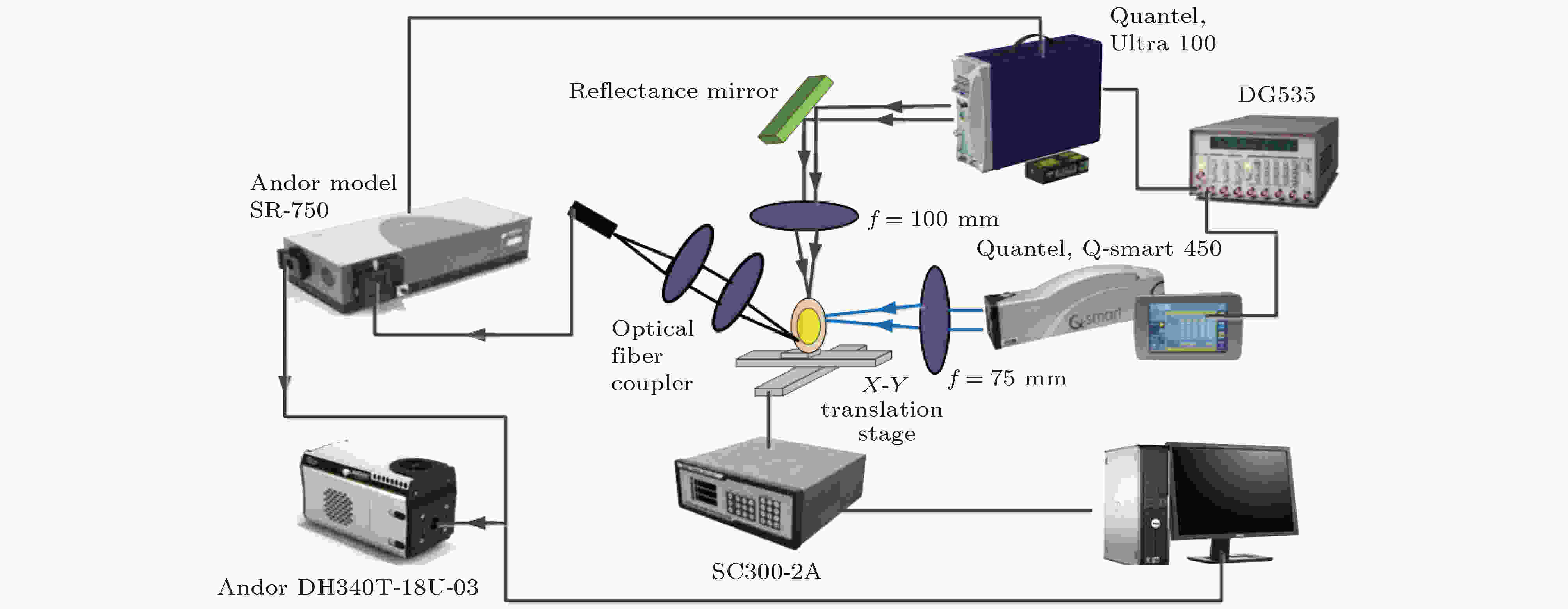 图 1 正交RDP-LIBS实验装置
图 1 正交RDP-LIBS实验装置Figure1. Schematic diagram of the experimental setup for orthogonal re-heating DP-LIBS.
2
2.2.样品制备
实验所用的样品购买于重庆中药材市场, 为实现再加热双脉冲LIBS技术对中药材重金属元素检测性能的评估, 对黄连进行了标准样品的制备, 首先通过粉碎机把不规则的黄连样品粉碎成粉末, 过筛(100目), 然后配置成含Cu浓度分别为20, 40, 80, 160, 300, 500, 800 mg/kg, 含Pb浓度分别为200, 400, 800, 1600, 3200, 6400和10000 mg/kg的样品, 最后, 使用液压机(10 MPa, 2 min)将其压成直径13 mm, 厚2 mm的中药材样品, 如图2所示. 图 2 黄连样品
图 2 黄连样品Figure2. Coptidis Chinensis samples.
3.1.双脉冲LIBS探测延时分析
由于特征谱线和背景辐射在激光诱导等离子的生命周期里表现出不同的特点, 所以通过调节ICCD的探测延时可以观察特征谱线在等离子生命周期内的时间演化规律. 本文首先把激光脉冲频率、ICCD探测门宽和脉冲间隔分别固定为4 Hz, 0.2 μs和1.5 μs, 主脉冲激光能量为E1 = 25 mJ和再加热脉冲激光能量E2 = 25 mJ; ICCD探测延时变化范围为0—4 μs, 间隔为0.5 μs, 特征谱线净光谱强度和信噪比随ICCD探测延时的变化如图3所示. 特征谱线Cu I (324.46 nm)和Pb I (405.78 nm)的光谱强度随延时的增加而降低, 而信噪比随着探测延时的增加先增加之后降低. 这是由于在等离子体产生初期主要由轫致辐射占主导, 高温等离子迅速向外膨胀并与外界进行能量交换, 连续背景辐射很强[22], 但是连续背景辐射的衰减速度比特征谱线的衰减速度要快, 故随着延时的增加, 信噪比逐渐增加, 最后由于等离子体逐渐消失, 特征谱线的强度减弱, 所以信噪比也逐渐减弱, 综合考虑信噪比和信号强度这两个因素, 选择1.5 μs和1.7 μs作为特征谱线Cu I (324.46 nm)与Pb I (405.78 nm)的最佳探测延时.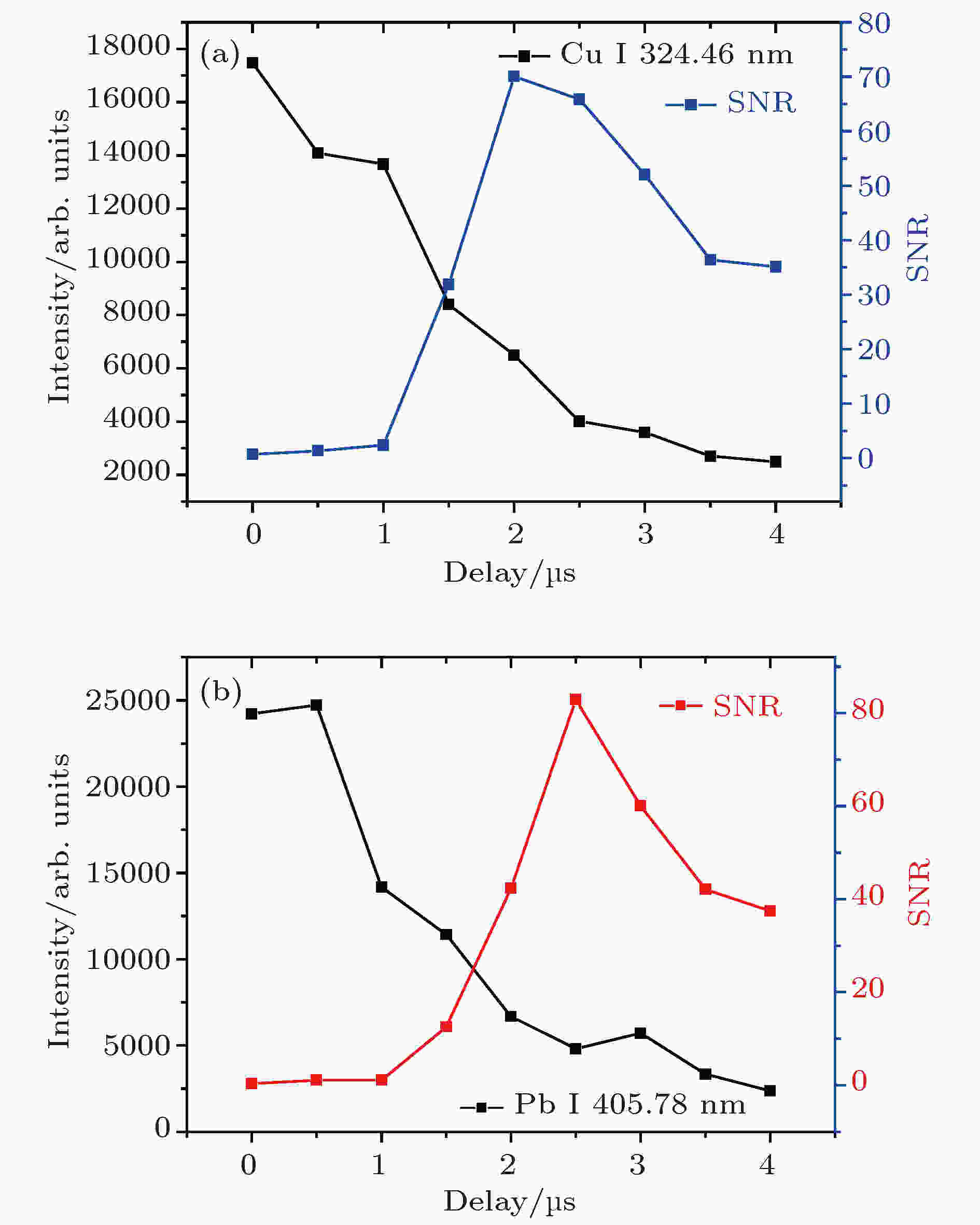 图 3 光谱强度和信噪比随探测延时的变化规律
图 3 光谱强度和信噪比随探测延时的变化规律Figure3. Evolutions of spectral intensity and signal-to-noise ratio (SNR) at different delay times.
2
3.2.双脉冲LIBS激光能量分析
LIBS特征谱线信号强度值会受到激光能量的影响, 从理论上讲, 随着激光能量的增大样品的烧蚀质量也会增加, 从而特征谱线的辐射概率也随之增加. 但是, 由于本文的样品是采用固体压片的方法, 若第一束激光能量值过高会损害物理压片的平整效果, 造成的烧蚀坑要比理论上更大, 致使样品质量损失严重, 同时增加击穿样品的粉尘溅射, 在短时间内粉尘都会笼罩在样品上方, 对第二束激光脉冲激发等离子体产生影响, 降低光谱信号的强度.为了研究两束激光能量比例对等离子体发射光谱强度的影响, 实验设定两束激光的总能量值为50 mJ, 分为e1 (E1 = 40 mJ, E2 = 10 mJ), e2 (E1 = 15 mJ, E2 = 35 mJ), e3 (E1 = 30 mJ, E2 = 20 mJ), e4 (E1 = 25 mJ, E2 = 25 mJ), e5 (E1 = 20 mJ, E2 = 30 mJ)共5组数据, 研究Cu I (324.46 nm)和Pb I (405.78 nm)特征谱线光谱强度随不同能量组的变化. Cu I (324.46 nm)和Pb I (405.78 nm)的探测延时分别为1.5 μs和1.7 μs, 激光频率和脉冲间隔分别为4 Hz和1.5 μs; 结果如图4所示, 对于特征谱线Cu I (324.46 nm)和Pb I (405.78 nm)在e2 (E1 = 15 mJ, E2 = 35 mJ)处光谱强度值最大, 可能由于当第一束激光作用于样品后瞬间形成等离子体, 等离子体随后向外扩散演化, 逐渐冷却衰减, 特征光谱强度也会逐渐减弱, 此时第二束激光脉冲经聚焦透镜会聚后产生高功率的激光能量能够再次加热冷却衰减的等离子体, 加剧等离子体内部的粒子间碰撞[23], 使特征光谱强度得到增强, 因此定量分析选择该能量组.
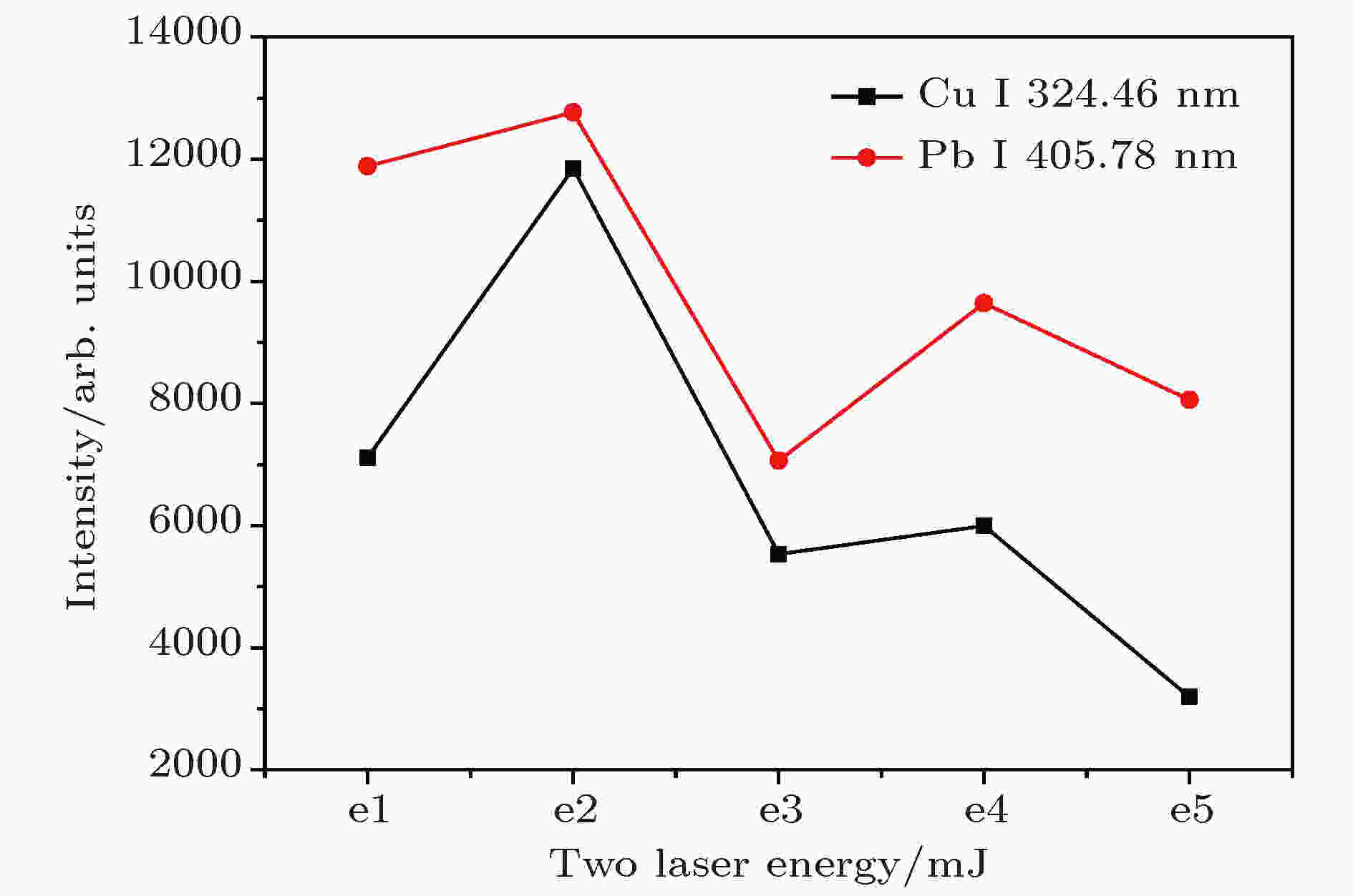 图 4 光谱强度随激光能量的变化
图 4 光谱强度随激光能量的变化Figure4. Variation of spectral intensity in different energy groups.
2
3.3.双脉冲LIBS脉冲间隔分析
脉冲间隔是影响双脉冲LIBS光谱强度的重要参数[24,25], 因为脉冲间隔会影响第二束激光与第一束激光诱导产生的等离子体相互作用的过程. 实验选择了800 mg/kg黄连样品作为研究对象, 通过控制数字脉冲延时发生器改变两束激光脉冲之间的时间变化, 主脉冲激光能量为E1 = 15 mJ, 再加热脉冲激光能量为E2 = 35 mJ, Cu I (324.46 nm)与Pb I (405.78 nm)特征谱线的ICCD探测延时分别为1.5 μs和1.7 μs, 激光脉冲频率为4 Hz, ICCD探测门宽为0.2 μs的条件下, 获得Cu和Pb元素光谱强度和信噪比随脉冲间隔的变化, 如图5所示. 分析图5可知Cu I (324.46 nm)谱线在0—0.8 μs之间光谱信号强度很高, 信噪比很低, 这是由于第一束激光诱导产生的等离子体随着脉冲间隔的变大, 体积增大, 进一步吸收了第二束激光能量, 使等离子体电子激发温度升高, 从而导致等离子体的轫致辐射增强, 但是随着脉冲间隔的继续变大, Cu I (324.46 nm)谱线特征信号开始减弱, 信噪比逐渐增大再减少. 而对于Pb I (405.78 nm)是该现象发生在1.2 μs之后. 综合考虑光谱强度和信噪比两个因素, 选择1.4 μs和1.6 μs分别作为Cu I (324.46 nm)与Pb I (405.78 nm)定量分析的脉冲间隔实验条件.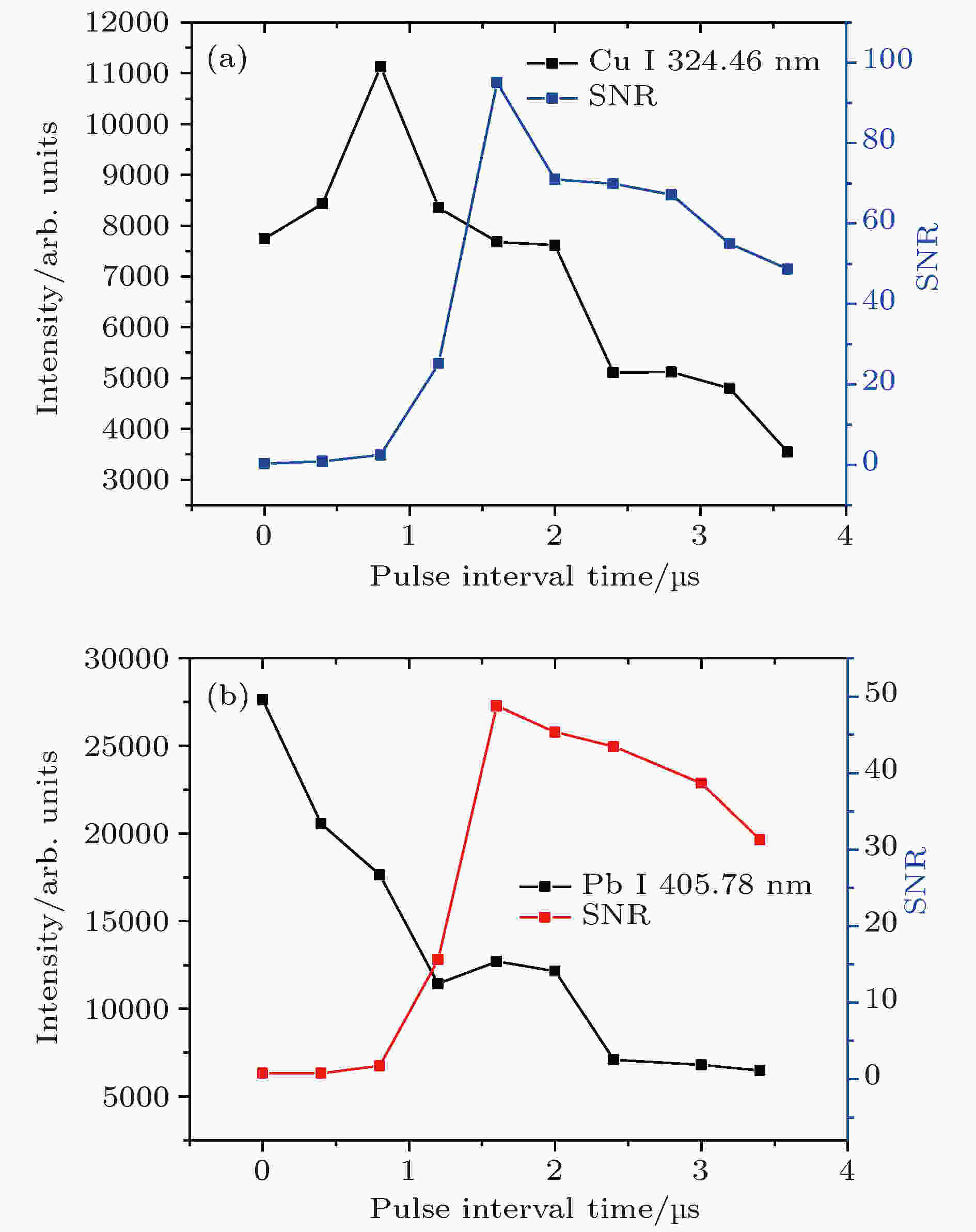 图 5 光谱强度和信噪比随脉冲间隔的变化
图 5 光谱强度和信噪比随脉冲间隔的变化Figure5. Variations of signal intensity and SNR as a function of pulse interval time
2
3.4.SP-LIBS与RDP-LIBS光谱强度对比
对重金属元素Cu与Pb进行定量分析时, 实验参数激光脉冲频率设置为4 Hz, 特征谱线Cu I (324.46 nm)在SP-LIBS条件下的激光能量值为50 mJ, ICCD探测延时为1.5 μs; RDP-LIBS的激光能量组值为(E1 = 15 mJ, E2 = 35 mJ), 脉冲间隔和探测延时分别为1.4 μs和1.5 μs; 同理特征谱线Pb I (405.78 nm)在SP-LIBS的条件下激光能量值为50 mJ, 探测延时为1.7 μs, RDP-LIBS的激光能量组值为(E1 = 15 mJ, E2 = 35 mJ), 脉冲间隔和探测延时分别为1.6 μs和1.7 μs. 所得光谱见图6, 可以看出Cu I (324.46 nm)特征谱线的光谱强度约从5779 counts增加到12749 counts, 增强了约2.2倍; Pb I (405.78 nm)特征谱线的光谱强度约从4703 counts增加到15838 counts, 增强了约3.3倍. 这是因为在合适的时间间隔内, 第二束激光对第一束激光形成的等离子体再加热, 导致光谱信号增强, 同时说明, 与SP-LIBS相比, RDP-LIBS可以提高被测元素的光谱强度.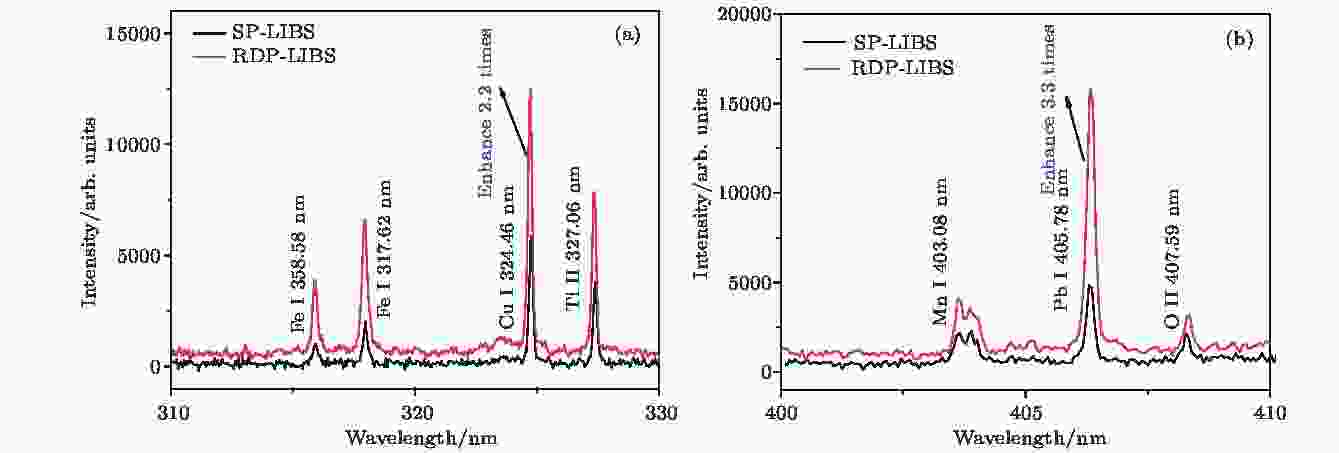 图 6 SP-LIBS和RDP-LIBS光谱强度对比
图 6 SP-LIBS和RDP-LIBS光谱强度对比Figure6. Comparison of spectral intensity between SP-LIBS and RDP-LIBS
2
3.5.定量分析
为了对比SP-LIBS和RDP-LIBS技术的检测性能, 本文使用外标法分别建立了黄连标准参考样品的Cu I (324.46 nm)和Pb I (405.78 nm)定标模型. 使用下列公式分析计算Cu I (324.36 nm)和Pb I (405.78 nm)特征谱线的检测限:

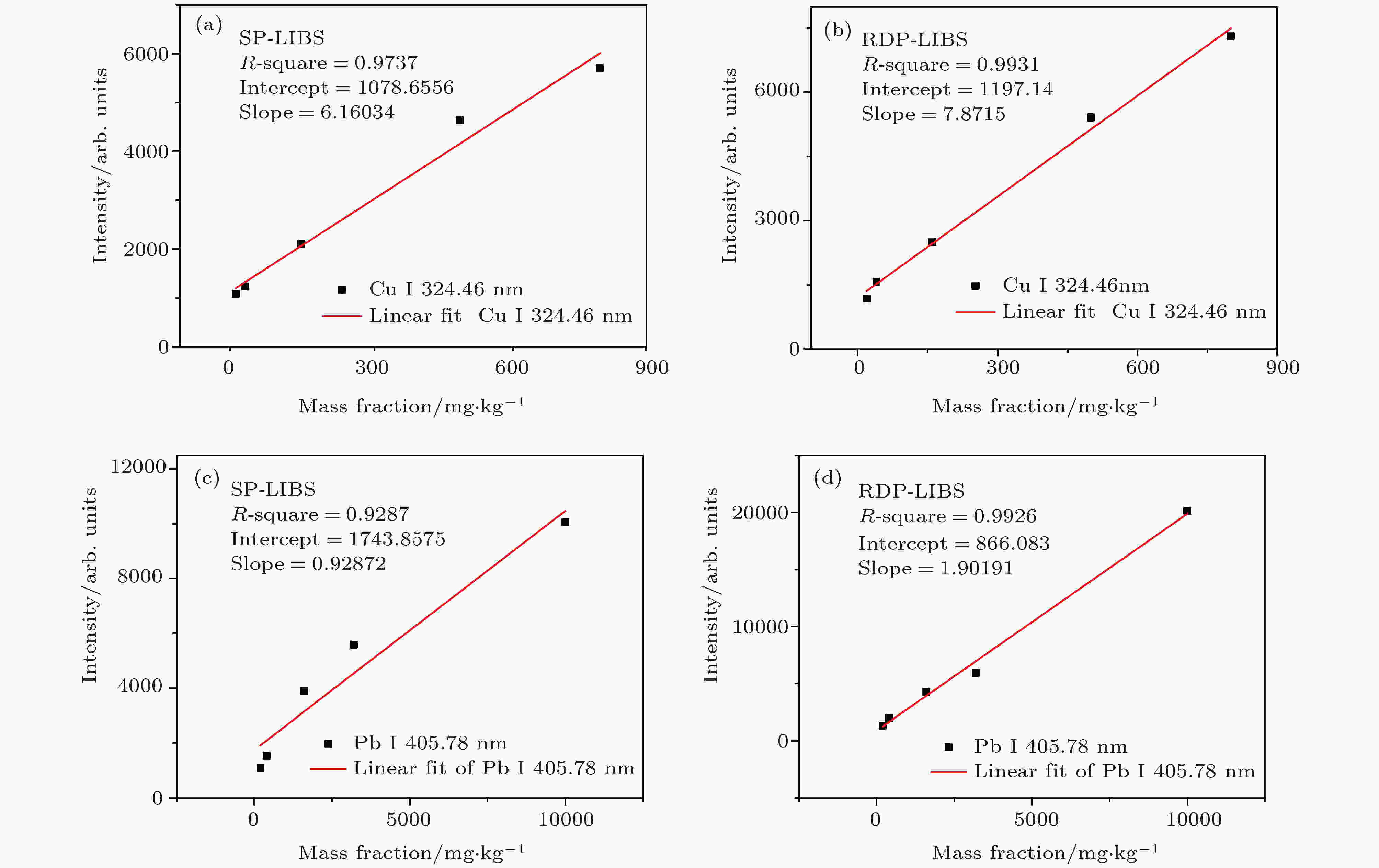 图 7 SP-LIBS和RDP-LIBS下Cu, Pb元素定标曲线拟合图
图 7 SP-LIBS和RDP-LIBS下Cu, Pb元素定标曲线拟合图Figure7. Linear fitting curves of Cu and Pb in SP-LIBS and RDP-LIBS.
| 特征谱线 | |||
| Cu I 324.46 nm | Pb I 405.78 nm | ||
| LOD/mg·kg–1 | SP-LIBS | 5.13 | 10.87 |
| RDP-LIBS | 1.91 | 3.03 | |
| GB/T 5009 | 20 | 5 | |
| R2 | SP-LIBS | 0.9738 | 0.9287 |
| RDP-LIBS | 0.9931 | 0.9926 | |
表1特征谱线的检测限(LOD)和线性拟合度(R2)对比
Table1.Comparison of detection limits and relative standard deviations of characteristic lines.
分析得知, SP-LIBS技术与RDP-LIBS技术对黄连中重金属Cu元素的检测限结果分别是5.13 mg/kg和1.91 mg/kg, Pb元素的检测限分别是10.87 mg/kg和3.03 mg/kg. 与SP-LIBS对比, 采用RDP-LIBS对黄连中重金属Cu元素的检测限降低了约10/27, 重金属Pb元素的检测限降低了约5/18. 说明RDP-LIBS方法在对黄连中重金属元素进行检测研究时, 其检测性能优于SP-LIBS方法, 且满足《药用植物进出口绿色行业标准》的要求.
此外, 为进一步验证RDP-LIBS的检测性能, 在上述的定标曲线中对重金属元素Cu和Pb元素进行检测分析, 检测结果如表2所列, 证明RDP-LIBS对重金属元素Cu和Pb元素检测性能优于SP-LIBS, 这是由于RDP-LIBS的第二束激光脉冲会使第一束激光脉冲烧蚀产生的等离子体再次激发, 使等离子发射光谱强度更强, 并且表明RDP-LIBS具有较好的检测准确度.
| 元素 | ||||||||||||
| 误差分析 | Cu | Pb | ||||||||||
| 实际值/mg·kg–1 | 测量值/mg·kg–1 | 相对误差/% | 精密度/% | 实际值/mg·kg–1 | 测量值/mg·kg–1 | 相对误差/% | 精密度/% | |||||
| SP-LIBS | 80 | 67.7 | 15.4 | 9.8 | 800 | 638.3 | 20.2 | 5.4 | ||||
| 300 | 244.4 | 18.5 | 7.6 | 6400 | 7163.5 | 11.9 | 4.2 | |||||
| RDP-LIBS | 80 | 69.5 | 13.1 | 7.8 | 800 | 693.9 | 13.2 | 3.6 | ||||
| 300 | 323.5 | 7.7 | 3.1 | 6400 | 5936.4 | 7.2 | 3.8 | |||||
表2Cu和Pb检测能力对比
Table2.Comparison of detection ability between Cu and Pb.
